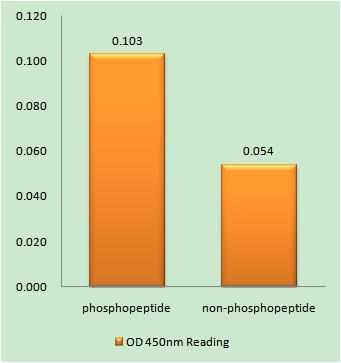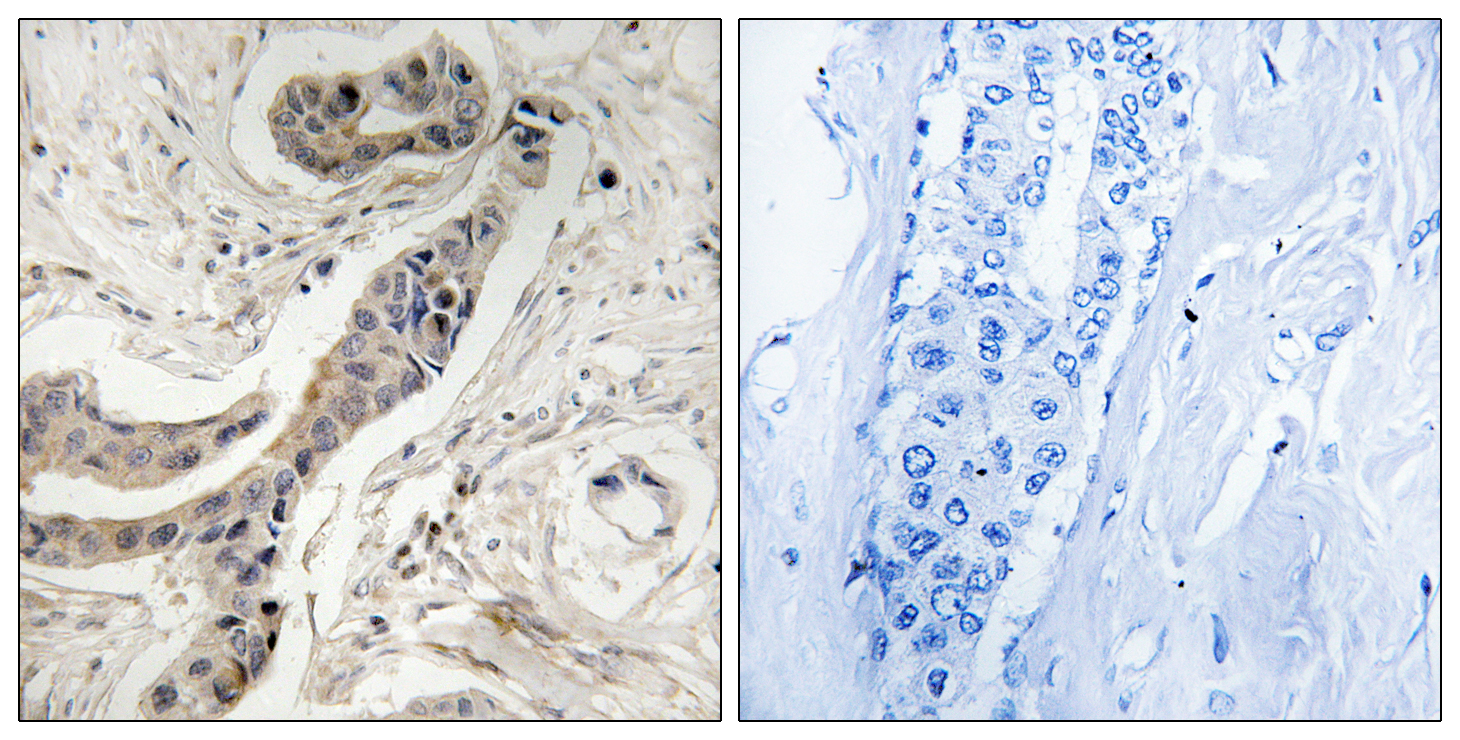Bcl-x (phospho Thr115) Polyclonal Antibody
- Catalog No.:YP1069
- Applications:IHC;IF;ELISA
- Reactivity:Human;Mouse;Rat
- Target:
- Bcl-x
- Fields:
- >>EGFR tyrosine kinase inhibitor resistance;>>Platinum drug resistance;>>Ras signaling pathway;>>NF-kappa B signaling pathway;>>p53 signaling pathway;>>Mitophagy - animal;>>Autophagy - animal;>>PI3K-Akt signaling pathway;>>Apoptosis;>>Apoptosis - multiple species;>>NOD-like receptor signaling pathway;>>JAK-STAT signaling pathway;>>Parkinson disease;>>Amyotrophic lateral sclerosis;>>Pathways of neurodegeneration - multiple diseases;>>Shigellosis;>>Toxoplasmosis;>>Measles;>>Human T-cell leukemia virus 1 infection;>>Herpes simplex virus 1 infection;>>Human immunodeficiency virus 1 infection;>>Pathways in cancer;>>Transcriptional misregulation in cancer;>>Pancreatic cancer;>>Chronic myeloid leukemia;>>Small cell lung cancer;>>Hepatocellular carcinoma;>>Lipid and atherosclerosis
- Gene Name:
- BCL2L1
- Protein Name:
- Bcl-2-like protein 1
- Human Gene Id:
- 598
- Human Swiss Prot No:
- Q07817
- Mouse Gene Id:
- 12048
- Mouse Swiss Prot No:
- Q64373
- Rat Gene Id:
- 24888
- Rat Swiss Prot No:
- P53563
- Immunogen:
- The antiserum was produced against synthesized peptide derived from human BCL-XL around the phosphorylation site of Thr115. AA range:81-130
- Specificity:
- Phospho-Bcl-x (T115) Polyclonal Antibody detects endogenous levels of Bcl-x protein only when phosphorylated at T115.
- Formulation:
- Liquid in PBS containing 50% glycerol, 0.5% BSA and 0.02% sodium azide.
- Source:
- Polyclonal, Rabbit,IgG
- Dilution:
- IHC 1:100 - 1:300. ELISA: 1:5000.. IF 1:50-200
- Purification:
- The antibody was affinity-purified from rabbit antiserum by affinity-chromatography using epitope-specific immunogen.
- Concentration:
- 1 mg/ml
- Storage Stability:
- -15°C to -25°C/1 year(Do not lower than -25°C)
- Other Name:
- BCL2L1;BCL2L;BCLX;Bcl-2-like protein 1;Bcl2-L-1;Apoptosis regulator Bcl-X
- Molecular Weight(Da):
- 26kD
- Background:
- The protein encoded by this gene belongs to the BCL-2 protein family. BCL-2 family members form hetero- or homodimers and act as anti- or pro-apoptotic regulators that are involved in a wide variety of cellular activities. The proteins encoded by this gene are located at the outer mitochondrial membrane, and have been shown to regulate outer mitochondrial membrane channel (VDAC) opening. VDAC regulates mitochondrial membrane potential, and thus controls the production of reactive oxygen species and release of cytochrome C by mitochondria, both of which are the potent inducers of cell apoptosis. Alternative splicing results in multiple transcript variants encoding two different isoforms. The longer isoform acts as an apoptotic inhibitor and the shorter isoform acts as an apoptotic activator. [provided by RefSeq, Dec 2015],
- Function:
- domain:The BH4 motif is required for anti-apoptotic activity. The BH1 and BH2 motifs are required for both heterodimerization with other Bcl-2 family members and for repression of cell death.,function:Potent inhibitor of cell death. Isoform Bcl-X(L) anti-apoptotic activity is inhibited by association with SIVA isoform 1. Inhibits activation of caspases (By similarity). Appears to regulate cell death by blocking the voltage-dependent anion channnel (VDAC) by binding to it and preventing the release of the caspase activator, cytochrome c, from the mitochondrial membrane. The Bcl-X(S) isoform promotes apoptosis.,PTM:Proteolytically cleaved by caspases during apoptosis. The cleaved protein, lacking the BH4 motif, has pro-apoptotic activity.,similarity:Belongs to the Bcl-2 family.,subcellular location:Mitochondrial membranes and perinuclear envelope.,subunit:Bcl-X(L) forms homodimers, and het
- Subcellular Location:
- [Isoform Bcl-X(L)]: Mitochondrion inner membrane . Mitochondrion outer membrane . Mitochondrion matrix . Cytoplasmic vesicle, secretory vesicle, synaptic vesicle membrane . Cytoplasm, cytosol . Cytoplasm, cytoskeleton, microtubule organizing center, centrosome. Nucleus membrane ; Single-pass membrane protein ; Cytoplasmic side . After neuronal stimulation, translocates from cytosol to synaptic vesicle and mitochondrion membrane in a calmodulin-dependent manner (By similarity). Localizes to the centrosome when phosphorylated at Ser-49. .
- Expression:
- Bcl-X(S) is expressed at high levels in cells that undergo a high rate of turnover, such as developing lymphocytes. In contrast, Bcl-X(L) is found in tissues containing long-lived postmitotic cells, such as adult brain.
- June 19-2018
- WESTERN IMMUNOBLOTTING PROTOCOL
- June 19-2018
- IMMUNOHISTOCHEMISTRY-PARAFFIN PROTOCOL
- June 19-2018
- IMMUNOFLUORESCENCE PROTOCOL
- September 08-2020
- FLOW-CYTOMEYRT-PROTOCOL
- May 20-2022
- Cell-Based ELISA│解您多样本WB检测之困扰
- July 13-2018
- CELL-BASED-ELISA-PROTOCOL-FOR-ACETYL-PROTEIN
- July 13-2018
- CELL-BASED-ELISA-PROTOCOL-FOR-PHOSPHO-PROTEIN
- July 13-2018
- Antibody-FAQs
- Products Images

- Enzyme-Linked Immunosorbent Assay (Phospho-ELISA) for Immunogen Phosphopeptide (Phospho-left) and Non-Phosphopeptide (Phospho-right), using BCL-XL (Phospho-Thr115) Antibody

- Immunohistochemistry analysis of paraffin-embedded human breast carcinoma, using BCL-XL (Phospho-Thr115) Antibody. The picture on the right is blocked with the phospho peptide.



